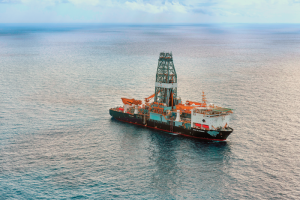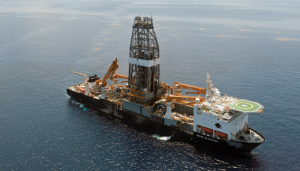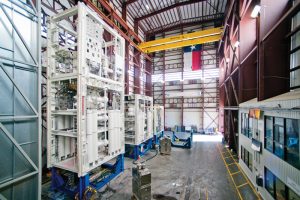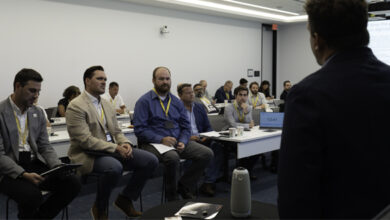Diamond Offshore, GE pursue step-changes in subsea BOP reliability, uptime through 10-year performance-based agreement
Contractor to pay daily rate for pressure control services while OEM will have full accountability for repair, maintenance of BOP systems aboard 4 drillships in GOM
By Linda Hsieh, Managing Editor

Diamond Offshore Drilling and GE Oil & Gas are turning tradition upside down with a first-of-its-kind contractual service agreement (CSA) aimed at increasing the economic viability of deepwater drilling. Under the 10-year agreement announced on 8 February, GE will buy back the subsea BOP systems aboard Diamond’s four drillships, currently located in the US Gulf of Mexico, for a total of $210 million. In turn, Diamond will pay GE for pressure-control services – but only when the BOP is available. “If they are on rate, we too are on a rate,” Chuck Chauviere, President of GE Oil & Gas Drilling Systems, said. “If they are off rate, we are off rate. It’s as simple as that.”
The idea was hatched at Diamond, where CEO/President Marc Edwards was seeking ways to drive efficiencies and lower costs, particularly in deepwater. “To make sure the rig is available for work more than it currently is, the low-hanging fruit is to address what I call the Achilles’ heel of deepwater drilling. That is the reliability of the subsea stack,” Mr Edwards said. “I don’t think there is any other industry that accepts the equipment downtime that we have – not aviation, not transportation, not manufacturing.”

Mr Edwards then thought back to his time at Halliburton, where he led the completion and production segment and spent six years working to improve the economics of shale drilling. “There, I had a large R&D department and a large manufacturing department. I could influence reliability. Here at Diamond, we don’t manufacture BOPs. We have to buy them from a third party,” he said.
Inspired by the model eventually adopted for electric submersible pumps, he decided that in order to improve the reliability and performance of BOPs, it had to be tied to financial incentives beyond the point of sale. Diamond then approached GE, and the two companies began crafting a CSA that could ultimately benefit both parties. “There’s a bonus for performance, but the critical factor is that we’re paying them a daily rate for pressure control. When they are unable to provide us with pressure control, we don’t pay them. If a BOP does not perform as expected and we have to pull the stack, the OEM now has skin in the game. That’s the difference,” Mr Edwards said. Diamond has coined this model Pressure Control by the Hour.

“Over the life of the BOP, we’re prepared to pay them more than what they would have received in a direct sale. However, by keeping our rig operating much better than it is today, our revenues will be higher. It’s a win-win.”
For GE, taking full accountability for the BOP’s performance means remaining much closer to the action, not just getting called transactionally or when the contractor needs a spare part. Under the agreement, GE will permanently station employees on the four Diamond drillships to oversee all maintenance and repair of the BOP equipment.
“There are two pieces to this – the planned piece and the unplanned piece,” Mr Chauviere said. Most people focus on the unplanned aspect of availability, “but when you look at the planned element, this is nonproductive time for the operator… What we realized through other businesses like power generation, aviation and transportation is that you can also improve planned maintenance when you predict and plan maintenance needs.”
Another aspect of the agreement is that GE will provide an evergreen certification of the BOP system. “The intent is there will be no expired certifications or the need to bring a system in for a major overhaul every five years. We are going to keep it in an evergreen state,” Mr Chauviere said.

Predictive technologies will play a significant role in this. “In other GE businesses, we have the ability to predict equipment performance over time, based on the environment that it’s in and the load that it’s under. We can predict its performance over time, so we can then forecast when is the right time for a planned outage or maintenance,” he explained.
The initial step will be to conduct robust equipment monitoring, supported by SeaLytics, a technology that connects to the data logger on the BOP. SeaLytics runs on GE’s Predix platform, which is the backbone of the company’s industrial internet. Mr Chauviere compared Predix to cloud-based operating systems used in the consumer and enterprise markets, along the lines of Apple’s operating systems. Predix is the cloud-based platform for the industrial market, whereas SeaLytics is the device itself – a mechanism that runs on Predix. “Between the two are applications, which can be things like algorithms for predictive logic. By opening the development of these apps to our customers, we believe Predix will improve asset productivity across the oil and gas industry.”
GE also will leverage technologies that have been developed around the concept of equipment fingerprinting to enhance the performance of the BOPs. “We have tools where we can leave a BOP stack assembled, and we can pass through the bore of the stack so that when the flanges are bolted up, we can do a through-bolt inspection of the bolts, the flange and the ring gasket without ever taking the BOP apart,” Mr Chauviere said. “Once we get that baseline, we can run the inspection again later and give you a rate of change as part of developing condition-based maintenance.”

The intent is to do a baseline fingerprint on the equipment, then do additional inspections at pre-determined intervals. “As we take that fingerprint technology and overlay it with the data that’s on the Predix backbone through SeaLytics, we can then begin to characterize the equipment’s performance. It will allow us to predictively utilize the equipment to extend its life.”
In addition, GE is developing acoustics technology that will add to the overall picture of the equipment. “When you start your car in the morning, you know what a good car start sounds like, and you know when it sounds different,” Mr Chauviere said. The same concept can be applied to BOPs, where sensors can be installed subsea to listen to the system when it operates. “You will establish a baseline after you filter out the noise, and over time you will know when it sounds like it’s wearing.”
Acoustics can also be used to pinpoint where a concern is located using triangulation, as well as help to size leaks in the BOP. “Right now you have to jump in an ROV, put dye in the system and go look for it. But if the leak is small, you may never see it.”
GE has already used the fingerprinting technology offshore for certifications, and prototyping has been done with the acoustics technology, although additional work is needed before it can be deployed in drilling applications, according to GE. “We have a road map for the progression of our technology. Once we have all these pieces knitted together within the SeaLytics and Predix package, that’s when we will get into the predictive element.”
Although the drilling industry has traditionally been slow to adopt new technologies, such as the ones that Mr Chauviere described, that will no longer be a barrier for GE and Diamond in this project. That’s because technology adoption related to the maintenance of the BOP will now be the decision of the service company, not the drilling contractor.
“It is now incumbent upon us to propose when is the right time to introduce a technology, and the only reason we would introduce the technology is if it improves the availability of the system,” Mr Chauviere said. “As opposed to the old transactional way where we try to convince the contractor of the value of a new piece of technology, it’s now on the OEM to evolve technology and deliver value because it’s tied to remuneration. You can argue that all we’ve done is tip the responsibility, but it truly has compressed who is accountable for what. The driller can go drill, and we can design and maintain.”
Challenges and expected results
Because this type of performance-based service agreement is unprecedented in the drilling industry for such a mission-critical and complex piece of equipment, both Diamond and GE say they realize that implementation will not be as easy as turning on a light switch. One challenge that must be overcome is knowledge transfer, Mr Chauviere said. “As an OEM, we have our product knowledge. The contractor has knowledge of how to use the equipment. That knowledge transfer is something that has to occur for us to truly work alongside their teams. This is why you have pit crews talking to race car drivers – it’s a feedback mechanism.
“The second big chasm we had to cross is just trust,” he continued. “We recognize the importance of this contract to Diamond Offshore. They’re truly trusting GE to step up and deliver. Both parties have made a commitment, and that’s why this CSA has a term of 10 years.” A leadership steering committee has been set up to facilitate communication between the two companies. “We know we’re going to find ourselves in a position where there are some challenges about what occurred, why it occurred and what the issues were around it. That’s why we have a leadership group that will meet and work on continuous improvement.”
Diamond expects to have two of its drillships begin the transition to GE support by March, a third in Q3 and the last in Q4. Mr Edwards notes that he recognizes the importance of managing change offshore and will maintain strong oversight during the transition period. He also emphasized that, under the agreement, Diamond maintains control and operation of the BOP stack at all times. “It’s still our drillship, and we are in control,” he said.
At this stage, it remains to be seen how this CSA will ultimately improve rig uptime and BOP reliability, but Mr Edwards said he expects to see at least a 50% reduction in downtime. “I can’t tell you exactly what the results will be, but I guarantee that the availability of the BOPs will go up,” he said, citing improvements that have been achieved in other industries once they adopted this type of performance-based business model. “It’s been proven in other industries that there’s a steeper curve in terms of performance improvement and reliability. There’s no reason to think it won’t happen here.” DC





BOP Risk Mitigation Services has a whole Suite of Smart-Tools tackling the reliability issue on multiple fronts how do we get an audience at either company, we have been attempting for several months.